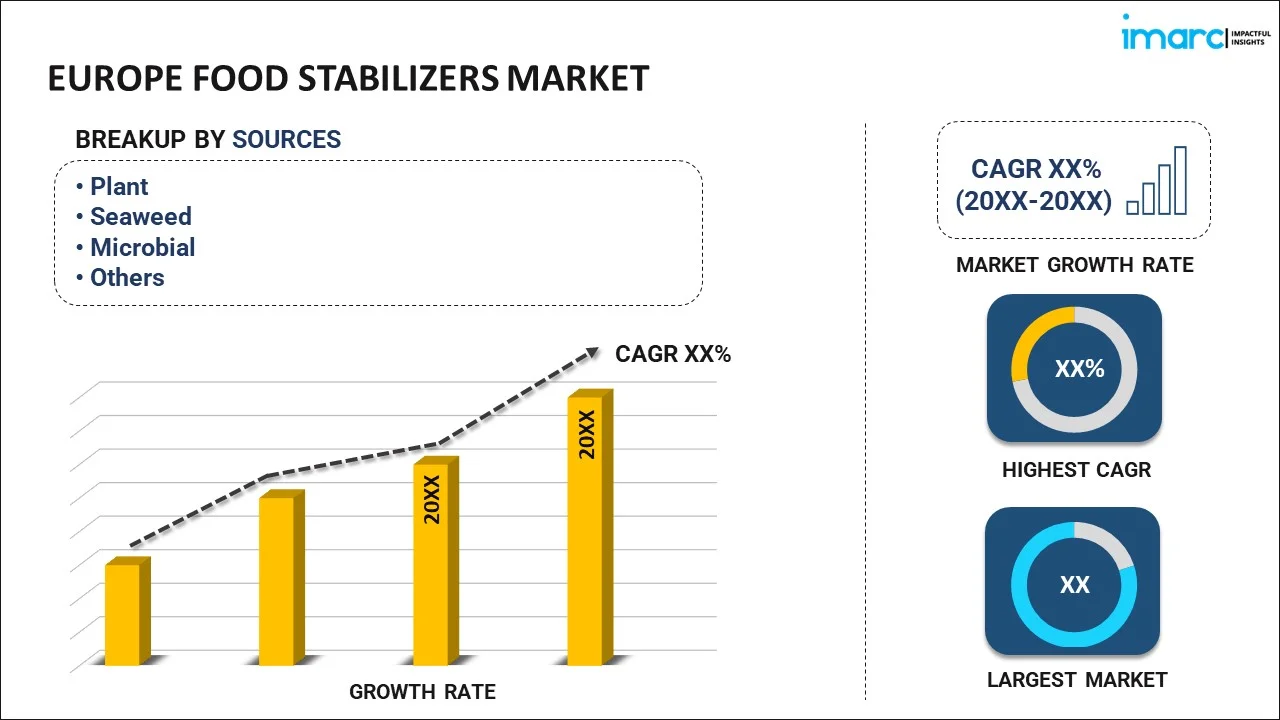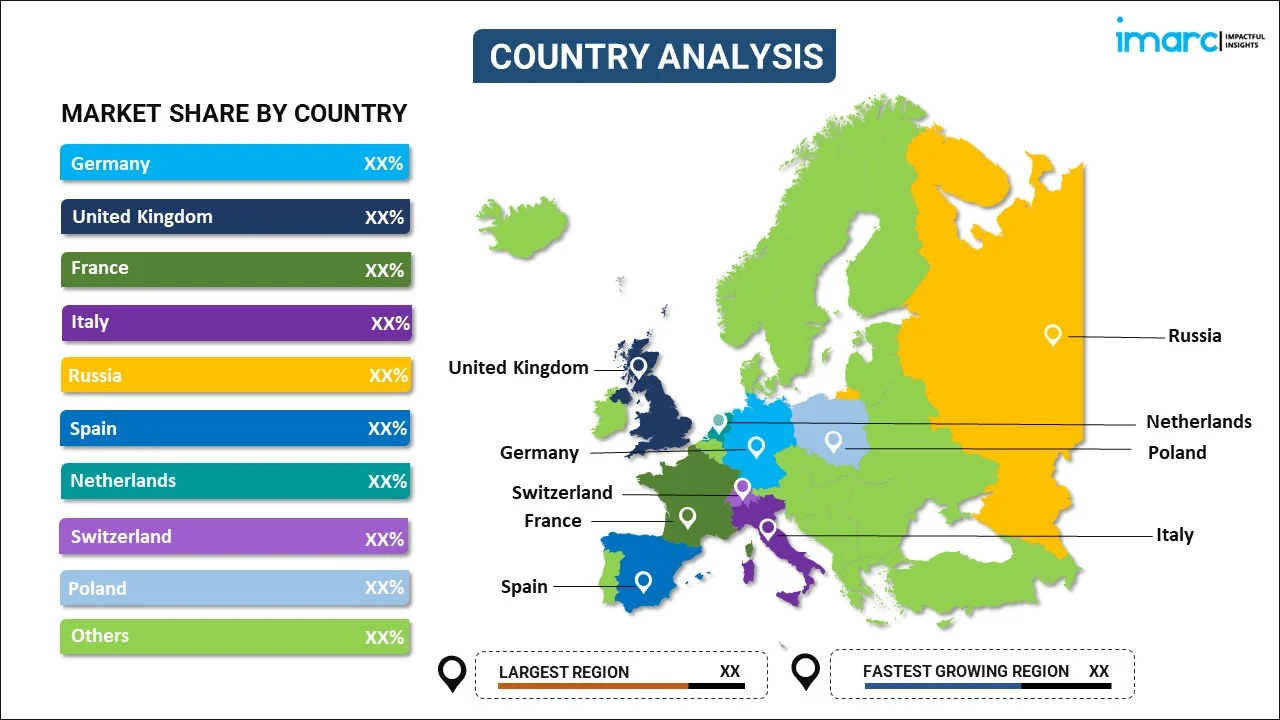
Europe Food Stabilizers Market Report by Source (Plant, Seaweed, Microbial, Animal, Synthetic), Function (Texturizing, Stabilizing, Moisture Retention, and Others), Application (Dairy and Dairy Products, Confectionery Products, Convenience Foods, Bakery Products, Meat and Poultry Products, Beverages, Sauces and Dressings, and Others), and Country 2025-2033
Market Overview:
Europe food stabilizers market size is projected to exhibit a growth rate (CAGR) of 4.60% during 2025-2033. The expanding food industry, including sectors like bakery, dairy, confectionery, and processed foods, which contributes to increased demand for food stabilizer, is primarily driving the regional market.
|
Report Attribute
|
Key Statistics
|
|---|---|
|
Base Year
|
2024 |
|
Forecast Years
|
2025-2033 |
|
Historical Years
|
2019-2024
|
| Market Growth Rate (2025-2033) | 4.60% |
Food stabilizers are substances added to food products to enhance and maintain their texture, consistency, and shelf life by preventing or slowing down undesirable changes. Common stabilizers include gums, gels, and emulsifiers, which contribute to the overall quality of various food items. They are essential in preventing separation, settling, or crystal formation, ensuring a consistent and appealing appearance. Stabilizers also play a crucial role in controlling moisture content, preventing the formation of ice crystals in frozen products, and improving the texture of baked goods. Additionally, they aid in the suspension of particles in beverages, such as preventing the settling of pulp in fruit juices. Food stabilizers are versatile and vital ingredients that contribute to the stability, visual appeal, and sensory experience of a wide range of processed foods.
Europe Food Stabilizers Market Trends:
The food stabilizers market in Europe is experiencing substantial growth, primarily driven by several key factors. Firstly, the increasing demand for processed and convenience foods has propelled the need for effective stabilizers to enhance texture, shelf life, and overall product quality. Additionally, consumer's evolving lifestyles and a growing preference for on-the-go meals have fostered the demand for stabilized products, driving market expansion. Moreover, the regional awareness of health and wellness has led to a surge in the consumption of natural and clean-label products. This trend has significantly impacted the food stabilizers market, as manufacturers seek stabilizers derived from natural sources to meet consumer expectations. Furthermore, the expanding food industry has bolstered the demand for stabilizers to maintain the integrity of diverse food formulations. In tandem with these factors, technological advancements in the development of innovative stabilizer solutions have played a pivotal role in market growth. Manufacturers are continuously investing in R&D to create novel stabilizers that cater to specific functional requirements while addressing consumer preferences. These interrelated drivers underscore the dynamic nature of the food stabilizers market in Europe, positioning it as a critical component in the ever-evolving landscape of the food industry.
Europe Food Stabilizers Market Segmentation:
IMARC Group provides an analysis of the key trends in each segment of the market, along with forecasts at the regional and country levels for 2025-2033. Our report has categorized the market based on source, function, and application.
Source Insights:

- Plant
- Seaweed
- Microbial
- Animal
- Synthetic
The report has provided a detailed breakup and analysis of the market based on the source. This includes plant, seaweed, microbial, animal, and synthetic.
Function Insights:
- Texturizing
- Stabilizing
- Moisture Retention
- Others
A detailed breakup and analysis of the market based on the function have also been provided in the report. This includes texturizing, stabilizing, moisture retention, and others.
Application Insights:
- Dairy and Dairy Products
- Confectionery Products
- Convenience Foods
- Bakery Products
- Meat and Poultry Products
- Beverages
- Sauces and Dressings
- Others
The report has provided a detailed breakup and analysis of the market based on the application. This includes dairy and dairy products, confectionery products, convenience foods, bakery products, meat and poultry products, beverages, sauces and dressings, and others.
Country Insights:

- Germany
- United Kingdom
- France
- Italy
- Russia
- Spain
- Netherlands
- Switzerland
- Poland
- Others
The report has also provided a comprehensive analysis of all the major regional markets, which include Germany, United Kingdom, France, Italy, Russia, Spain, Netherlands, Switzerland, Poland, and Others.
Competitive Landscape:
The market research report has also provided a comprehensive analysis of the competitive landscape in the market. Competitive analysis such as market structure, key player positioning, top winning strategies, competitive dashboard, and company evaluation quadrant has been covered in the report. Also, detailed profiles of all major companies have been provided.
Europe Food Stabilizers Market Report Coverage:
| Report Features | Details |
|---|---|
| Base Year of the Analysis | 2024 |
| Historical Period | 2019-2024 |
| Forecast Period | 2025-2033 |
| Units | US$ Million |
| Scope of the Report | Exploration of Historical Trends and Market Outlook, Industry Catalysts and Challenges, Segment-Wise Historical and Future Market Assessment:
|
| Sources Covered | Plant, Seaweed, Microbial, Animal, Synthetic |
| Functions Covered | Texturizing, Stabilizing, Moisture Retention, Others |
| Applications Covered | Dairy and Dairy Products, Confectionery Products, Convenience Foods, Bakery Products, Meat and Poultry Products, Beverages, Sauces and Dressings, Others |
| Countries Covered | Germany, United Kingdom, France, Italy, Russia, Spain, Netherlands, Switzerland, Poland, Others |
| Customization Scope | 10% Free Customization |
| Post-Sale Analyst Support | 10-12 Weeks |
| Delivery Format | PDF and Excel through Email (We can also provide the editable version of the report in PPT/Word format on special request) |
Key Questions Answered in This Report:
- How has the Europe food stabilizers market performed so far and how will it perform in the coming years?
- What has been the impact of COVID-19 on the Europe food stabilizers market?
- What is the breakup of the Europe food stabilizers market on the basis of source?
- What is the breakup of the Europe food stabilizers market on the basis of function?
- What is the breakup of the Europe food stabilizers market on the basis of application?
- What are the various stages in the value chain of the Europe food stabilizers market?
- What are the key driving factors and challenges in the Europe food stabilizers?
- What is the structure of the Europe food stabilizers market and who are the key players?
- What is the degree of competition in the Europe food stabilizers market?
Key Benefits for Stakeholders:
- IMARC’s industry report offers a comprehensive quantitative analysis of various market segments, historical and current market trends, market forecasts, and dynamics of the Europe food stabilizers market from 2019-2033.
- The research report provides the latest information on the market drivers, challenges, and opportunities in the Europe food stabilizers market.
- Porter's five forces analysis assist stakeholders in assessing the impact of new entrants, competitive rivalry, supplier power, buyer power, and the threat of substitution. It helps stakeholders to analyze the level of competition within the Europe food stabilizers industry and its attractiveness.
- Competitive landscape allows stakeholders to understand their competitive environment and provides an insight into the current positions of key players in the market.
Need more help?
- Speak to our experienced analysts for insights on the current market scenarios.
- Include additional segments and countries to customize the report as per your requirement.
- Gain an unparalleled competitive advantage in your domain by understanding how to utilize the report and positively impacting your operations and revenue.
- For further assistance, please connect with our analysts.
 Inquire Before Buying
Inquire Before Buying
 Speak to an Analyst
Speak to an Analyst
 Request Brochure
Request Brochure
 Request Customization
Request Customization




.webp)




.webp)












